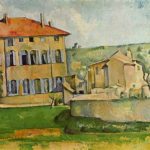Impressionist Period
Impressionist Period
Provence and Paris, 1870–1878

After the start of the Franco-Prussian War in July 1870, Cézanne and his mistress, Marie-Hortense Fiquet, left Paris for L’Estaque, near Marseilles, where he changed themes to predominantly landscapes. He was declared a draft dodger in January 1871, but the war ended the next month, in February, and the couple moved back to Paris, in the summer of 1871. After the birth of their son Paul in January 1872, in Paris, they moved to Auvers in Val-d’Oise near Paris. Cézanne’s mother was kept a party to family events, but his father was not informed of Hortense for fear of risking his wrath. The artist received from his father a monthly allowance of 100 francs.
Camille Pissarro lived in Pontoise. There and in Auvers he and Cézanne painted landscapes together. For a long time afterwards, Cézanne described himself as Pissarro’s pupil, referring to him as “God the Father”, as well as saying: “We all stem from Pissarro.” Under Pissarro’s influence Cézanne began to abandon dark colours and his canvases grew much brighter.
Leaving Hortense in the Marseille region, Cézanne moved between Paris and Provence, exhibiting in the first (1874) and third Impressionist shows (1877). In 1875, he attracted the attention of the collector Victor Chocquet (de), whose commissions provided some financial relief. But Cézanne’s exhibited paintings attracted hilarity, outrage, and sarcasm. Reviewer Louis Leroy said of Cézanne’s portrait of Chocquet: “This peculiar looking head, the colour of an old boot might give [a pregnant woman] a shock and cause yellow fever in the fruit of her womb before its entry into the world.”
In March 1878, Cézanne’s father found out about Hortense and threatened to cut Cézanne off financially, but, in September, he relented and decided to give him 400 francs for his family. Cézanne continued to migrate between the Paris region and Provence until Louis-Auguste had a studio built for him at his home, Bastide du Jas de Bouffan, in the early 1880s. This was on the upper floor, and an enlarged window was provided, allowing in the northern light but interrupting the line of the eaves. This feature remains today. Cézanne stabilized his residence in L’Estaque. He painted with Renoir there in 1882 and visited Renoir and Monet in 1883.
